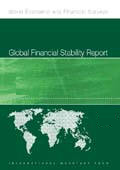Global Financial Stability Report (October 2010) shows that t he inability of multiple financial institutions to roll over or obtain new short-term funding was one of the defining characteristics of the crisis. Systemic liquidity risks were underrecognized by both the private and public sectors and required unprecedented intervention by governments and central banks during the crisis. This report discusses the vulnerabilities that led to the systemic liquidity crunch and, in doing so, provides a holistic framework for dealing with them, with central banks expected to step in only in dire emergencies.
he inability of multiple financial institutions to roll over or obtain new short-term funding was one of the defining characteristics of the crisis. Systemic liquidity risks were underrecognized by both the private and public sectors and required unprecedented intervention by governments and central banks during the crisis. This report discusses the vulnerabilities that led to the systemic liquidity crunch and, in doing so, provides a holistic framework for dealing with them, with central banks expected to step in only in dire emergencies.
 he inability of multiple financial institutions to roll over or obtain new short-term funding was one of the defining characteristics of the crisis. Systemic liquidity risks were underrecognized by both the private and public sectors and required unprecedented intervention by governments and central banks during the crisis. This report discusses the vulnerabilities that led to the systemic liquidity crunch and, in doing so, provides a holistic framework for dealing with them, with central banks expected to step in only in dire emergencies.
he inability of multiple financial institutions to roll over or obtain new short-term funding was one of the defining characteristics of the crisis. Systemic liquidity risks were underrecognized by both the private and public sectors and required unprecedented intervention by governments and central banks during the crisis. This report discusses the vulnerabilities that led to the systemic liquidity crunch and, in doing so, provides a holistic framework for dealing with them, with central banks expected to step in only in dire emergencies.A key aspect of the crisis was the increased use by banks of short-term wholesale funding and the risks that it posed when these short-term markets dried up. Perhaps insufficiently recognized was that the wholesale providers of funds had also changed instead of interbank markets acting to move unsecured funds where needed, other intermediaries, such as money market mutual funds, were growing suppliers of funds while traditional, more stable depositors were not. Secured lending through repurchase operations
also grew immensely, greasing the funding markets.
The report shows that going forward a comprehensive approach is needed to better mitigate systemic liquidity risks. Higher liquidity buffers and lower asset/liability maturity mismatches in banks will help to reduce the chance that an individual institution will run into liquidity difficulties. Click here to access chapers 2 & 3 of the report.
No comments:
Post a Comment